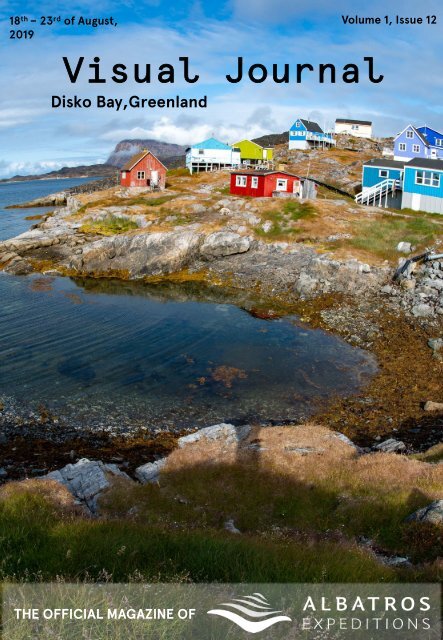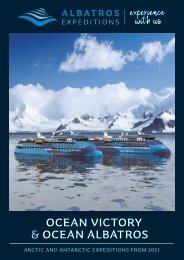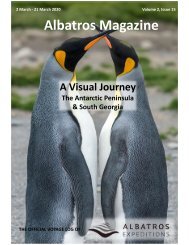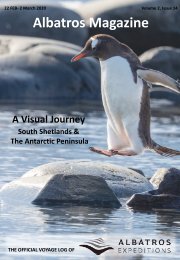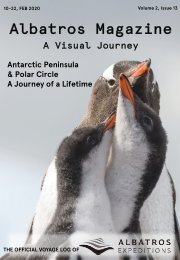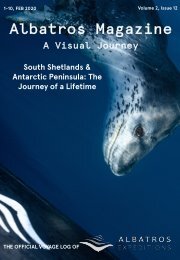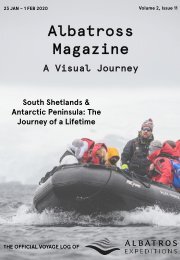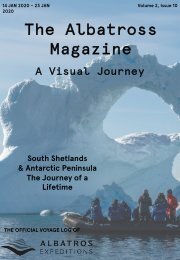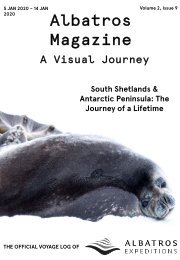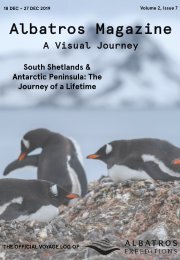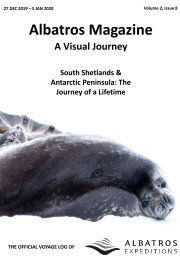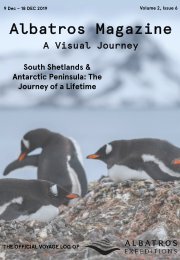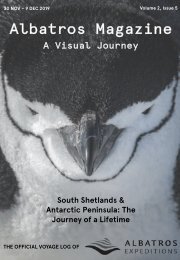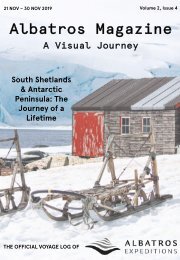Voyage 12 - Greenland Disko Bay
Create successful ePaper yourself
Turn your PDF publications into a flip-book with our unique Google optimized e-Paper software.
18 th – 23 rd of August,<br />
2019<br />
Volume 1, Issue <strong>12</strong><br />
Visual Journal<br />
<strong>Disko</strong> <strong>Bay</strong>,<strong>Greenland</strong><br />
THE OFFICIAL MAGAZINE OF
Visual Journal<br />
Editor-in-Chief:<br />
Staff Writers:<br />
Layout & Design:<br />
Expedition Leader:<br />
Assistant Expedition Leader:<br />
Shop Manager:<br />
Expedition Photographer:<br />
Zodiac Master:<br />
Hiking Master:<br />
Kayak Master:<br />
Expedition Guide/Lecturer:<br />
Front Cover Image:<br />
Back Cover Image:<br />
Photography Contributors:<br />
Aaron Strahlke<br />
Steve Egan<br />
Ursula Tscherter<br />
Rashidah Lim<br />
Gregers Gjersøe<br />
Aaron Strahlke<br />
Gaby Pilson<br />
Sam Gagnon<br />
Ted Creek<br />
Anne Dorthe Jacobsen<br />
Nadine Smith<br />
Renato Granieri<br />
Steve Traynor<br />
Gregers Gjersøe<br />
Steve Egan<br />
Aaron Strahlke<br />
Rashidah Lim<br />
Ursula Tscherter<br />
Mikaela von Koskull<br />
Jakob Schytz<br />
Laali Berthelsen<br />
Itilleq © Renato Granieri Photography<br />
Ilulissat © Renato Granieri Photography<br />
Renato Granieri Photography<br />
Gaby Pilson<br />
Gregers Gjersøe<br />
Aaron Strahlke<br />
© Renato Granieri Photography<br />
18-23 August, 2019 Volume 1, Issue <strong>12</strong>
TABLE OF CONTENTS<br />
The <strong>Voyage</strong><br />
By the Numbers<br />
Day 1: Kangerlussuaq<br />
The Seven Sisters of Szczecin<br />
Day 2: Sisimiut<br />
What makes an Expedition Guide?<br />
Day 3: Qeqertarsuaq<br />
Ice is Nice – Glacier Fun Facts<br />
Day 4: Ilulissat<br />
Through the Lens<br />
Day 5: Itilleq<br />
Becoming an Expedition Guide<br />
Day 6: Kangerlussuaq<br />
A Brief History of the Zodiac<br />
A Final Note<br />
4<br />
5<br />
6<br />
7<br />
8<br />
9<br />
10<br />
11<br />
<strong>12</strong><br />
13<br />
14<br />
15<br />
16<br />
17<br />
18
The <strong>Voyage</strong><br />
Page 4<br />
The following map traces the approximate route that the M/V Ocean Atlantic took during our<br />
voyage From Svalbard to via <strong>Greenland</strong> . You can find more information about our day to day<br />
activities, landings, and excursions on the following pages. We hope that this magazine serves as a<br />
reminder of all of the wonderful memories you made while experiencing the Arctic with us at<br />
Albatros Expeditions.<br />
© Renato Granieri Photography<br />
© Renato Granieri Photography<br />
18-23 August, 2019 Volume 1, Issue <strong>12</strong>
By the Numbers…<br />
Page 5<br />
<strong>Voyage</strong> Statistics:<br />
Northernmost Point: 69 o 47.300’N<br />
Total Distance Travelled: 787 nautical miles<br />
Number of guests: 104<br />
Number of guides: 14<br />
Kangerlussuaq:<br />
Sisimiut:<br />
Qeqertarssuaq:<br />
Eqip Sermia:<br />
Ilulissat:<br />
Itilleq:<br />
Excursion Locations:<br />
67 o 00.031’N, 50 o 41.021’W<br />
66 o 56.020’N, 53 o 40.020’W<br />
69 o 14.050’N, 53 o 32.000’W<br />
69 o 47.300’N, 50 o 18.003’W<br />
69 o 13.000’N, 51 o 06.000’W<br />
66 o 34.038’N, 53 o 29.058’W<br />
© Renato Granieri Photography<br />
18-23 August, 2019 Volume 1, Issue <strong>12</strong>
Day 1: Kangerlussuaq<br />
18 August 2019 - Embarkation Day<br />
In the early hours of the morning, M/V Ocean<br />
Atlantic glided the final stretch of her long passage of<br />
almost 200 km, along the Kangerlussuaq Fjord,<br />
connecting the sea beyond to the main international<br />
airport for <strong>Greenland</strong>. Here, a small township nestles<br />
in the glacial hills, existing entirely to support the<br />
associated tourism that uses the airport & services<br />
the ships that sail into the nearby port.<br />
Kangerlussuaq was established by the USA as an<br />
airbase, firstly in WW2 and then further reinforced<br />
by Cold war tensions and most of the infrastructure<br />
was designed and built almost a century ago. In more<br />
recent times with the fall of the Soviet Union, its<br />
importance diminished and the population waned.<br />
While tourism and air transport keeps the town alive,<br />
plans to relocate <strong>Greenland</strong>’s air hub to the capital of<br />
Nuuk, may forever change Kangerlussuaq’s value as a<br />
destination that supports the local economy.<br />
Port days are busy and intensely organized days for<br />
the ship’s hard-working crew. 104 guests flying in to<br />
join us from as far afield as North America, Canada &<br />
from nearby Europe, we had much to prepare to<br />
welcome them all in the best way. As the warm<br />
northern summer sun beamed down on us, we<br />
cleaned our good ship & prepared ourselves for the<br />
journey ahead. Soon enough it seemed, our guests<br />
Page 6<br />
From the <strong>Voyage</strong> Log<br />
© Aaron Strahlke<br />
began to arrive from their airport transfer from<br />
Iceland; it’s always an exciting time to meet new<br />
faces that will share the journey with us. Ahead of<br />
us, some good days of exploring highlights of<br />
<strong>Greenland</strong>. There was much to look forward to!<br />
While the warm afternoon sun had become the cool<br />
breezes of twilight, we made our way by zodiac<br />
from jetty to ship.<br />
With formalities completed - luggage placed in<br />
cabins, passports collected for safe-keeping, and<br />
mandatory briefing, our newly arrived guests had a<br />
few moments to become accustomed to what<br />
would be their home for the next days of<br />
adventures. In the Viking Theatre, a safety drill<br />
cleared us to sail away from port, and it was already<br />
time for a social dinner in our Vinland restaurant<br />
which we enjoyed as MV Ocean Atlantic sailed for<br />
the distant horizon. After a lengthy day of travel, it<br />
was time to rest and enjoy the deep sleep that<br />
naturally follows.<br />
“<br />
© Aaron Strahlke<br />
We can only ever experience true<br />
beauty in nature when we are<br />
brave enough to seek it…<br />
”<br />
As we’re on an expedition, we know full well that<br />
there are no guarantees. We are at the mercy of the<br />
weather, the wildlife, and the landscape of this cold<br />
place. But, as explorers know all too well, we can<br />
only ever experience true beauty in nature when<br />
we are brave enough to seek it out amongst the<br />
mountains and the seas in the world’s most remote<br />
places. It is with that sentiment in mind that we<br />
venture away from Kangerlussuaq and north, to the<br />
future and all the wonders it holds.<br />
18-23 August, 2019 Volume 1, Issue <strong>12</strong>
The Seven Sisters of Szczecin<br />
David MacDonald, Lecturer (Geology) & Expedition Guide<br />
M/V Ocean Atlantic was launched in 1986 as the<br />
last-built of the ‘Shoshtakovich’ class of icestrengthened<br />
passenger vessels, alongside six sister<br />
ships, together known as the “Seven Sisters of<br />
Szecsecin”.<br />
Her original name was Konstantin Chernenko<br />
(Константин Черненко), after the President of the<br />
USSR (1984-1985). She was renamed Russ (Русс) in<br />
1989, and spent much of her life working in the<br />
Russian Far East.<br />
She was purchased by Albatros Expeditions and<br />
completely refitted in 2017. She is now a 200-<br />
passenger expedition vessel and is one of the<br />
strongest polar cruise ships afloat. Here are some<br />
fun facts about the “Seven Sisters”:<br />
• All seven ships were built by Stocnia Szczecinska<br />
shipyard in Szczecin, Poland between 1979-1986<br />
• Main engines: 4 x Skoda Sulzer 6LZ40 total power<br />
<strong>12</strong>800 kW, giving a maximum speed of 18 knots<br />
• Most of the class have one bow thruster (736 kW)<br />
and one stern thruster (426 kW); however, two<br />
ships, including ours, built in 1986, have two stern<br />
thrusters, each of 426 kW<br />
• Feature Siemens stabilisers for seaworthiness<br />
• Although built as ferries, they have a<br />
strengthened car deck for transport of tanks<br />
• Two of them had diving chambers<br />
• MV Mikhail Sholokov had hull demagnetising<br />
Page 7<br />
equipment so it could operate in minefields<br />
• All of these ships have been scrapped except ours<br />
and Konstantin Simonov – now Ocean Endeavour<br />
Our ship has had a complex history:<br />
1986-1987 In Baltic traffic, then Vladivostok to<br />
Japan & S Korea<br />
1989 renamed to Russ<br />
1997-1999 In traffic Stockholm-Riga; 2000<br />
Odessa-Haifa; 2002 back to<br />
Vladivostok transporting cars from<br />
Japan<br />
2007 Sold to Sea Ferry Shipping in Majuro<br />
and renamed 2010 to Atlantic;<br />
renovations in Italy and in traffic<br />
Stockholm-Helsinki-St.Petersburg<br />
during summer and laid up (October<br />
2010) in St Petersburg<br />
20<strong>12</strong> Sold to ISP in Miami and renamed to<br />
Ocean Atlantic under Marshall<br />
Islands flag<br />
2013 Used as a hotel ship in the German<br />
bight wind farm project<br />
2015-2017 Laid up in Helsingborg and taken to<br />
Gdansk in Poland, where totally<br />
refitted<br />
2017 Chartered to Quark Expeditions<br />
2017-present Chartered to Albatros Expeditions.<br />
© Renato Granieri Photography<br />
18-23 August, 2019 Volume 1, Issue <strong>12</strong>
Day 2: Sisimiut<br />
19 August 2019 – Our First Settlement<br />
After a good and healthy breakfast in the morning, we<br />
all met in the Viking Theatre to get briefed about our<br />
day in Sisimiut.<br />
Sisimiut, the capital of the Qeqqata Kommunia, has<br />
5500 inhabitants and is the second largest city in<br />
<strong>Greenland</strong> after Nuuk. The city was founded in 1764<br />
but the area of Sisimiut has been inhabited by people<br />
of the Saqqaq and Dorset culture as well as the Thule<br />
people, whom the current population is descendants<br />
from, for nearly 4500 years. First established as a<br />
trading station Holsteinborg, which mainly traded<br />
reindeer hide, the city is today one of <strong>Greenland</strong>’s<br />
education towns with an Engineering school and a<br />
foreign language school to name a few.<br />
We had guided walks into the town to visit our very<br />
first <strong>Greenland</strong>ic settlement. From the ship we headed<br />
to the oldest part of Sisimiut which is a museum today.<br />
There we were offered a variety of <strong>Greenland</strong>ic food<br />
to taste. For example, seal blubber, reindeer soup, and<br />
dried cod. Well fed, we continued towards the Blue<br />
Church, which is one of the oldest churches in<br />
<strong>Greenland</strong>.<br />
© Renato Granieri Photography<br />
From the <strong>Voyage</strong> Log<br />
Page 8<br />
© Renato Granieri Photography<br />
After our guided walk through Sisimiut we had the<br />
opportunity to visit the museum and the different<br />
shopping possibilities before most of us headed back to<br />
the ship for lunch.<br />
In the afternoon, a guided hike was offered to a nearby<br />
island from which we had a new point of view towards<br />
the colorful painted houses. The sunny weather in<br />
combination with the beautiful scenery made this hike<br />
to something really special.<br />
Back on board and departing from Sisimiut we all went<br />
to the Viking Theatre to listen to a mandatory Zodiac<br />
safety briefing to prepare ourselves for our landing on<br />
the next day. Before dinner, we met again in the Viking<br />
Theatre to listen to our plans for the following day in<br />
detail and to be officially welcomed by our Hotel<br />
Manager Oliver who introduced the services on board.<br />
Then it was time for the Captains welcome cocktail<br />
party and the introduction of the officers of our home<br />
far from home for the next days.<br />
The Blue Church was constructed in Denmark and then<br />
shipped to Sisimiut after the citizens bought it from<br />
the Danes for 60 barrels of whale oil. As the town<br />
grew, there was not enough space in the church for all<br />
citizens. Therefore in 1925, a new church was build,<br />
the “Red Church”. We entered it and were amazed by<br />
the beautiful wooden construction work inside.<br />
While we continued our guided walk, we also saw a<br />
couple of <strong>Greenland</strong>ic dogs. These dogs are working<br />
dogs and not used to be pet. So, we admired them<br />
from the distance while they enjoyed with us this<br />
gorgeous sunny day.<br />
© Renato Granieri Photography<br />
18-23 August, 2019 Volume 1, Issue <strong>12</strong>
What Makes an Expedition Guide?<br />
Brian Seenan, Lecturer (Geology) & Expedition Guide<br />
A good expedition guide wants you to enjoy as much as of your<br />
destination as possible. You’ve chosen it carefully and you’re<br />
hungry for information: what do penguins eat, what kind of bird<br />
is that, is that a volcano, why are beluga whales white, does the<br />
sea go all the way around that island? So, we’d better be ready.<br />
Page 9<br />
“<br />
We each have a personal style and<br />
specialization, but one thing unites us all:<br />
our curiosity for the natural world.<br />
”<br />
We find it so fascinating, we do it for a job. If we’re not guiding,<br />
you’ll find us checking out new and interesting places and<br />
things. Every day, we look forward to learning something new,<br />
like how people lived 5,000 years ago or how seals can delay<br />
gestation, so they only return to shore once to give birth and<br />
mate. This kind of thing fascinates us all.<br />
We want to share this stuff with you, so expect us to be<br />
enthusiastic. We’ll fess up if we don’t know every answer, but<br />
we’ll aim to find it – we don’t like uncertainty any more than<br />
you. We enjoy being with people, and talking about what we<br />
see and feel, even if it’s 2 o C below, with a biting wind.<br />
We take care of you, but not like your mom, and we make sure<br />
you don’t fall out of the Zodiac trying to get a perfect shot of a<br />
puffin. We take courses to drive our Zodiacs well. We learn first<br />
aid, so we can handle the unexpected.<br />
© Renato Granieri Photography<br />
More than anything, we want you to enjoy your adventure.<br />
Everything is there in front of you - the scenery, the wildlife, the<br />
plants and the geology; as guides, we hope we bring them to<br />
life for you.<br />
© Gaby Pilson<br />
© Gaby Pilson © Gaby Pilson<br />
18-23 August, 2019 Volume 1, Issue <strong>12</strong>
Day 3: Qeqertarsuaq<br />
20 August– The <strong>Disko</strong> Island with Polka Dancers<br />
This morning we stepped foot on the pier of<br />
Qeqertarsuaq, also known as Godhavn, located on the<br />
South coast of <strong>Disko</strong> Island. Although it was a bit chilly<br />
at first, the sun got stronger with the hour creating<br />
ideal conditions for the hikers as well as the guests<br />
exploring the town. At the pier some of us visited the<br />
museum right away while the others walked through<br />
town and along the beach ending at an outdoor dance<br />
floor where the local dance group offered us a<br />
performance.<br />
Page 10<br />
From the <strong>Voyage</strong> Log<br />
Lynda was wearing her colourful kamik made of seal<br />
skin and created by her mother-in-law. Over her<br />
shoulders, she carried the nuilarmiut made of hundreds<br />
of colourful glass beats moving with the rhythm of the<br />
© Renato Granieri Photography<br />
music. Her partner Jakob was dressed in the more<br />
simple costume for men with black pants and kamik<br />
and a white long-sleaved shirt. It was impressive to<br />
watch the pairs spinning faster and faster. Then it was<br />
our turn and many of us found ourselves dancing on<br />
the floor. The impressive mountains on one and the<br />
majestic icebergs on the other side while the wind<br />
carried the sound of our laughter out to the sea.<br />
Meanwhile the hikers had climed the nearby ridge and<br />
enjoyed a fantastic view over the ocean.<br />
© Renato Granieri Photography<br />
Next Jakob shared his knowledge on the history and<br />
culture of <strong>Disko</strong> <strong>Bay</strong>. He is a descendant of the Thule<br />
people who lived from 200 BC to 1600 AD and were<br />
followed by the Inuits of today. Beside Western Eskimo<br />
and Eastern Eskimo a third language not<br />
understandable to the others exists and is named<br />
Aleut. Jakob also explained that <strong>Disko</strong> <strong>Bay</strong> was<br />
“discovered” in 985 AD by Eric the Red and followed by<br />
whalers and traders. To date traces of the Saqqaq,<br />
Dorset and Thule Eskimos can be found at various<br />
sites.<br />
During the afternoon the Ocean Atlantic sailed through<br />
the fjord to reach our evening destination, Eqip<br />
Sermia. The impressive glacier offered the ideal<br />
scenery for our polar plunge as five brave guests took<br />
on the challenge watched and cheered by the others.<br />
Finally another day filled with very diverse and unique<br />
experiences came to an end with a glass of mulled<br />
wine served on the top deck.<br />
Back on board we set sail towards our next destination,<br />
Eqip Sermia, and our hotel crew spoiled us with a tasty<br />
BBQ on the back deck. After a relaxing break Ursula<br />
gave an introduction to marine mammals and the<br />
humpback whale. She explained how they evolved from<br />
a land living mammal and that engineers work on a new<br />
design for airplane and windmill wings based on<br />
humpback flippers with unique humps along the edges.<br />
© Renato Granieri Photography<br />
At the end Ursula presented her life-sized humpback<br />
whales; a year-old of 8.5 m and a tiny new-born of 4.5<br />
m. They gave a real impression of how big the adults of<br />
up to 16 m are. Ursula produces these mock-ups for<br />
education as part of her project 1:1 with animals.<br />
18-23 August, 2019 Volume 1, Issue <strong>12</strong>
Ice is Nice – Glacier Fun Facts<br />
Gaby Pilson, Hiking Master & Expedition Guide<br />
Page 11<br />
Glaciers have, quite literally, shaped our world. Without glaciers, the rolling hills and wide valleys we know<br />
today would look very different, but it turns out that these icy giants have a much longer and more storied<br />
history than many of us would initially suspect. Here are some of the best fun facts about glaciers:<br />
2<br />
4<br />
© Renato Granieri Photography<br />
Glaciers are formed by snowflakes. Although it’s<br />
crazy to think that a tiny snowflake can create<br />
something as large as a glacier, without snow,<br />
glaciers would never exist in the first place. To<br />
form a glacier, massive amounts of snow must<br />
accumulate and persist in a single location all<br />
year-long for hundreds, if not thousands of<br />
years. During this time, the individual snowflakes<br />
found in the snowpack change in a process<br />
known as snowflake metamorphosis, where<br />
individual ice grains fuse together and get bigger<br />
and air bubbles get smaller. Once the icepack<br />
builds up enough mass to start flowing downhill,<br />
then voila! We have a glacier.<br />
© Renato Granieri Photography<br />
1<br />
3<br />
Not just anything can be a glacier. In fact, there’s<br />
a size requirement that a piece of ice has to<br />
meet to become a glacier. Anything considered a<br />
glacier must be at least 0.1 km 2 (nearly 25 acres)<br />
in area to be worthy of the name. Although<br />
there’s a minimum size requirement to be<br />
considered a glacier, there’s no upper limit to<br />
glacierhood. The longest glacier on earth is the<br />
Lambert Glacier of Antarctica, which measures<br />
out to some 434 km (270 mi) long. The world’s<br />
largest non-polar glacier is the Fedchenko<br />
Glacier of Tajikistan, which measures a<br />
respectable 77km (48mi) long.<br />
© Renato Granieri Photography<br />
Glaciers are found all over the world, not just in<br />
the polar regions. While the majority of glaciers<br />
and glacial ice is concentrated in high northern<br />
and southern latitudes, glaciers are found even<br />
near the equator, such as on Mount Kilimanjaro<br />
in Tanzania and in the mountains of Ecuador.<br />
That being said, about half of the world’s<br />
200,000 glaciers are found in one place: Alaska.<br />
There, glaciers cover a whopping 72,500 km 2<br />
(28,000 mi 2 ) of the US state’s total area. That’s a<br />
lot of ice.<br />
Glaciers are basically really, really, really slow-moving rivers. To be considered a glacier, a large mass of ice<br />
must be physically moving downhill. This movement downhill is driven by gravity and is the main reason<br />
why glaciers also act as major agents of erosion. Since glaciers move downhill, they often remove and<br />
transport large boulders and chunks of rock, depositing them much further downhill then where they<br />
started.<br />
18-23 August, 2019 Volume 1, Issue <strong>12</strong>
Day 4: Ilulissat<br />
21 August 2019 – Icebergs and Whales<br />
Our day started with a great breakfast and a view<br />
directly to the icebergs of Ilulissat contrasted by the<br />
colorful houses of the town. With a view this<br />
magnificent it was hard to get to shore, but the promise<br />
of better views lured most on land.<br />
Page <strong>12</strong><br />
From the <strong>Voyage</strong> Log<br />
Ilulissat is <strong>Greenland</strong>’s tourism capital. It is easy to see<br />
why with its neighbour being a huge iceberg field, from<br />
which the city got its name.<br />
Nearly all guests took the beautiful sightseeing boat<br />
tour, as many others who come to Ilulissat do. The<br />
serene look is broken only by the thunderous cracks,<br />
reminding us of the inevitable calving.<br />
Even before the first zodiac arrives, the harbor is busy<br />
with fishermen and hunters walking around. Housing<br />
the main administration for the municipality of<br />
Avannaata Kommunia the city is truly the capital of the<br />
North.<br />
© Renato Granieri Photography<br />
The city also felt our arrival, and the handicraft shop<br />
sold out their goods, which they quickly restocked for<br />
later visits.<br />
The city started as a small missionary station for the<br />
large Inuit population in Sermermiut. Today the city is<br />
quite large in <strong>Greenland</strong>ic standards with 4500 people,<br />
who relies mostly on fishing, but tourism is becoming<br />
an ever-growing part of the economy.<br />
With most passengers on land the ship was quiet but<br />
laid outside of town waiting and dodging some of the<br />
stray growlers coming floating by. We went back to the<br />
ship to enjoy dinner before we set sail towards Itilleq.<br />
© Renato Granieri Photography<br />
As the guests eagerly arrived at the harbour, it was a<br />
little chilly and cloudy. Thankfully, as the day<br />
progressed, the sun began to shine through the clouds,<br />
much to our relief. We were not the only guests on this<br />
day. Humpback whales have made this area their<br />
summer feeding waters. These majestic creatures<br />
frolicked and looked curiously towards the many tour<br />
boats flocking towards them. With their distinct fins<br />
these gentle giants are easy to spot, even our flight<br />
sightseeing guests could enjoy the splendor from the<br />
plane. Humpback whales migrate here due to the<br />
waters around Ilulissat being rich in krill, capelin and<br />
other small fish. These are in turn here due to the<br />
constant flow of icebergs stirring the nutrients around,<br />
and since the glacier is the most active glacier in the<br />
northern hemisphere there is plenty of this!<br />
© Renato Granieri Photography<br />
© Renato Granieri Photography<br />
18-23 August, 2019 Volume 1, Issue <strong>12</strong>
Through the Lens<br />
Gaby Pilson, Hiking Master & Expedition Guide<br />
Although he spends most of his time with his face hidden behind his camera<br />
trying to get that perfect shot, Expedition Photographer Renato Granieri is<br />
one of the best known members of the Albatros Staff. Whether you go to<br />
him for help with dialing in your camera settings or you just want to learn<br />
more about how to shoot an amazing image of a bird in flight, Renato is your<br />
go-to-photographer. We sat down with Renato to learn more about what<br />
makes him tick. Here’s what we learned:<br />
What’s the inspiration behind your photography?<br />
The beauty of photography is in how much you can<br />
learn from the environment around you. Every<br />
time I sit in front of a subject, I discover new things<br />
about it and the world that I never even thought<br />
about before. Much of this is because of how a<br />
camera works. The camera is much faster than the<br />
human brain, so it lets me freeze a moment and<br />
see something I wouldn’t otherwise notice.<br />
In your opinion, what is the most essential trait a<br />
wildlife or travel photographer needs to have?<br />
A passion for discovery, a thorough understanding<br />
of your subject, and a staunch determination to get<br />
the images you’re looking for are critical in this<br />
discipline. Photographers need to constantly push<br />
themselves to search for novel situations and fresh<br />
perspectives while experimenting with new and<br />
creative ways to use a camera.<br />
Page 13<br />
You specialise in wildlife and travel photography.<br />
What motivates you to get out and shoot in<br />
remote and extreme environments?<br />
I have always been drawn to the remoteness and<br />
silence of the wilderness. These places are both<br />
unique and remarkable as the lack of human<br />
presence, the extreme environmental conditions,<br />
and the amazing lighting make them unparalleled<br />
stages for photography.<br />
Renato’s Tips of the Trade<br />
1. Always shoot with a goal. Plan your shots<br />
carefully and take different factors, such as<br />
weather, location, subject, and light into account.<br />
2. Experiment as much as possible. Try to be bold<br />
and creative with your techniques.<br />
3. Don’t always look for sunshine. Often, dramatic<br />
skies and “poor” weather can make the most<br />
interesting photos.<br />
All Photos © Renato Granieri Photography<br />
18-23 August, 2019 Volume 1, Issue <strong>12</strong>
Day 5: Itilleq<br />
From the <strong>Voyage</strong> Log<br />
22 August 2019 – A small settlement with a big heart<br />
Page 14<br />
Ocean Atlantic headed south after saying goodbye to<br />
the icebergs in <strong>Disko</strong> bay. The morning greetings from<br />
the bridge included the familiar words of every<br />
morning from the Expedition leader, Sam Gagnon:<br />
“Good morning, good morning”. Sam informed us of<br />
the ship’s position, where we were going and the<br />
weather forecast, which was looking good. We were<br />
heading to our last landing in the small settlement of<br />
Itilleq in the Qeqqata municipality, which we would<br />
reach in the afternoon.<br />
We joined Anne Dorthe for her presentation “Modern<br />
<strong>Greenland</strong>” and after the Recap and briefing on the<br />
next two days plan, we joined Aaron`s interesting<br />
presentation “Snow, Icebergs and Glaciers”.<br />
Itilleq settlement is located on a small island around 1<br />
km from the mainland, 45 km south of Sisimiut and<br />
only 2 km north of the Arctic Circle on the shores of<br />
the Davis Strait.<br />
Itilleq with only 100 inhabitants greeted us in the<br />
afternoon. The town has only small gravel roads in the<br />
settlement leading up to the graveyard in the East and<br />
the school and church at the other end of the<br />
settlement. There was no risk of getting lost.<br />
We could still hear the howls of <strong>Greenland</strong> sled dogs,<br />
as Itilleq is the southernmost location allowed to have<br />
this ancient breed, being only 2 kilometres above the<br />
Arctic Circle. Consequently, no other types of canines<br />
are allowed above this point, in order to keep the<br />
breed pure.<br />
© Renato Granieri Photography<br />
© Renato Granieri Photography<br />
The main trade in the settlement is fishing and hunting,<br />
with a fish factory being the principal employer in the<br />
settlement. The island has no freshwater, and for this<br />
reason Itilleq makes use of a facility for forming<br />
freshwater from seawater.<br />
© Renato Granieri Photography<br />
Coming back to the ship in the afternoon we had<br />
afternoon tea in the Libary and before dinner we had<br />
the Captains Farewell toast in the Viking Theatre.<br />
The Ocean Atlantic set course for Kangerlussuaq, which<br />
we would reach on the next morning.<br />
18-23 August, 2019 Volume 1, Issue <strong>12</strong>
Becoming an Expedition Guide<br />
Gregers Gjersøe, Snowshoe Master & Expedition Guide<br />
Page 15<br />
Back in 1999, I crossed <strong>Greenland</strong> on skis with two of<br />
my Danish friends. When we finally made it to the top<br />
of the ice cap, we decided to celebrate by flying the<br />
Danish and the <strong>Greenland</strong>ic flag. Unfortunately, we<br />
ended up placing the <strong>Greenland</strong>ic flag upside down<br />
because none of us was sure which way was correct...<br />
During the remainder of the expedition, as we made<br />
our way down from the top of the ice cap, I started<br />
thinking more about why and how three Danish guys<br />
could possibly know so little about <strong>Greenland</strong>, despite<br />
the fact that it’s a part of the Kingdom of Denmark.<br />
When I returned home, I decided to learn all I could<br />
about <strong>Greenland</strong> and the polar regions, travelling<br />
extensively, not only to <strong>Greenland</strong>, but throughout the<br />
Arctic and the Antarctic. The polar areas became my<br />
passion and have been for the last twenty years. I<br />
became so fascinated by the polar regions, that I<br />
wanted to share my knowledge and love for these<br />
places with other people. There is so much to love and<br />
experience in the polar regions, from great scenery<br />
and wildlife to the culture of the peoples who have<br />
populated the Arctic since time immemorial.<br />
© Renato Granieri Photography<br />
I haven’t always worked in the polar regions, though.<br />
Since childhood, I was very interested in navigation,<br />
aerodynamics, metrology and aviation. I acquired my<br />
pilot’s license in 1985 and worked as a commercial<br />
pilot for Scandinavian Airlines during a 30 year career.<br />
There, I was able to satisfy all of my interests while<br />
learning how to work as part of a team, bringing the<br />
aircraft from point A to point B in the safest way<br />
possible.<br />
After ending my pilot career, I took up yet another<br />
dream of mine that had occupied my mind since<br />
crossing <strong>Greenland</strong>. In Danish schools, there is very<br />
little focus on the history and cultures of <strong>Greenland</strong><br />
and the Faroe Islands; thus, there is very little<br />
awareness within the Danish population about these<br />
countries. I wanted to create a much better awareness<br />
and, therefore, I started the Polar School<br />
(Polarskolen).<br />
The school is run as a non-profit organization with a<br />
board of nine members. I am chairman of the board<br />
and there are members from the Danish government,<br />
from <strong>Greenland</strong>, the Faroe Islands as well as teachers.<br />
We have received funding from the Royal Crown<br />
Prince Frederik and his wife, Crown Princess Mary.<br />
Now, I travel Denmark, visiting schools with our<br />
educational materials. Presently we teach 7 th graders,<br />
but we are working towards having materials for 1 st<br />
graders and 4 th graders.<br />
Based on my background and experience in aviation<br />
and in the polar regions, I could not think of a better<br />
way to combine my passions for the Arctic and the<br />
Antarctic then to become Expedition Guide. These<br />
days, I spend five weeks of the summer in the Arctic<br />
and five weeks of the winter in the Antarctic, so I can<br />
show our guests all the places that I truly love.<br />
© Renato Granieri Photography<br />
18-23 August, 2019 Volume 1, Issue <strong>12</strong>
Day 6: Kangerlussuaq<br />
23 August 2019 – Disembarkation Day<br />
Page 16<br />
From the <strong>Voyage</strong> Log<br />
After last night’s end-of-voyage festivities, we awoke<br />
much too early for our final morning on the Ocean<br />
Atlantic. As the Ocean Atlantic pulled into its anchorage<br />
in Kangerlussuaq, we started the process of leaving<br />
behind the ship and the people we’ve come to know so<br />
well over the past few days.<br />
Our bags were packed and stowed in the corridors,<br />
ready for our early-morning busses and flights back to<br />
Copenhagen, and everywhere in between. After all of<br />
our days immersed in the landscapes and amongst the<br />
wildlife of the Arctic, it was time to return home or to<br />
wherever our life’s journeys bring us.<br />
And so – farewell, adieu, and goodbye. Together we<br />
have visited an incredible and vast wilderness. We have<br />
experienced magnificent mountain vistas, seen icebergs<br />
and glaciers, felt the power of the elements<br />
© Gregers Gjersøe<br />
On behalf of Albatros Expeditions, our<br />
captain and crew, the expedition team, and<br />
everyone else who helped make this<br />
journey a resounding success, it has been a<br />
pleasure travelling with you.<br />
We hope that you will come back and<br />
experience these wonderful places with us<br />
once again!<br />
© Gregers Gjersøe<br />
and seen how quickly they can change. We enjoyed<br />
wonderful food and comfortable surroundings aboard<br />
the Ocean Atlantic. We saw an icy fjord at the end of<br />
the Earth. We have shared unique moments, held<br />
engaging conversations, and laughed together over<br />
beers and coffees. We’ve made new friends and<br />
experienced the power of expeditionary travel.<br />
We hope the expedition team has helped make this the<br />
trip of a lifetime - one that will persist in your memories<br />
for weeks, months, and years, to come. Although we<br />
must say good-bye to these places we have come to<br />
know and love, it is a fond farewell as we are all true<br />
ambassadors for the Arctic and all the beauty it holds.<br />
© Aaron Strahlke<br />
18-23 August, 2019 Volume 1, Issue <strong>12</strong>
A Brief History of the Zodiac<br />
Steve Traynor, Zodiac Master<br />
In expedition cruising, the most important tool we use is the Zodiac inflatable boat. These manoeuvrable,<br />
reliable, robust vessels are the workhorse of the expedition cruise industry, from the north of Svalbard to<br />
the southern end of the Antarctic Peninsula. They have a long history – as you can see from the stages<br />
below, many different inventions needed to come together to create the craft we use today.<br />
Page 17<br />
© Renato Granieri Photography<br />
1838 Charles Goodyear (USA) discovered the process for vulcanising rubber (a US patent was granted<br />
in 1844) – this process is used for hardening and strengthening rubber.<br />
1843 Goodyear’s process was stolen by Thomas Hancock (UK) using the process of reverse<br />
engineering; less controversially, Hancock invented the “masticator” – a machine for re-using<br />
rubber scraps – this made the rubber industry much more efficient.<br />
1845 The first successful inflatable boat (Halkett boat) was designed by Lieutenant Peter Halkett<br />
(UK), specifically for Arctic operations. Halkett Boats were used by the Orcadian explorer, John<br />
Rae, in his successful expedition to discover the fate of the Franklin Expedition.<br />
1866 Four men made the first crossing of the Atlantic Ocean from New York to Britain on a threetube<br />
inflatable raft.<br />
1896 The original Zodiac company was founded by Maurice Mallet (France) to produce airships.<br />
1909 The first outboard motor was invented by Ole Evinrude in Milwaukee, Wisconsin.<br />
19<strong>12</strong> The loss of the Titanic and subsequent shipping losses during World War 1 proved the need for<br />
inflatable rafts for use as supplementary lifeboats.<br />
1919 RFD firm (UK) and the Zodiac company (France) started building inflatable boats.<br />
1934 The airship company, Zodiac, invented the inflatable kayak and catamaran<br />
1942 The Marine Raiders – an elite unit of the US Marine Corps – used inflatable boats to carry out<br />
raids and landings in the Pacific theatre.<br />
1950 Alain Bombard first combined the outboard engine, a rigid floor and an inflatable boat (built by<br />
the Zodiac company).<br />
1952 Alain Bombard crossed the Atlantic Ocean with his inflatable; after this, his good friend, the<br />
famous diver Jacques-Yves Cousteau, started using them.<br />
1960 Zodiac licensed production to a dozen companies in other countries because of their lack of<br />
manufacturing capacity in France.<br />
18-23 August, 2019 Volume 1, Issue <strong>12</strong>
A Final Note…<br />
Page 18<br />
As any good expedition comes to a close, many of us experience the<br />
effervescent excitement that comes when we immerse ourselves<br />
completely in an adventure. Although we all came into this voyage with<br />
our own expectations and personal motivations, on the ship, we quickly<br />
learned that the best plan is the one that we end up doing.<br />
While weather and the landscape<br />
can conspire against us in the<br />
northern latitudes, the right mindset<br />
can make all of the difference.<br />
Wind, rain, sleet, and snow make no<br />
difference when we come prepared<br />
for an adventure and all the<br />
excitement it holds. Whether you<br />
saw what you came for or you<br />
experienced something else<br />
entirely, when you set out on an<br />
expedition, you come for the<br />
mountains and the wildlife, but stay<br />
for people and places you meet<br />
along the way.<br />
Although we all eventually have to<br />
leave behind our beloved Ocean<br />
Atlantic, there are always a few<br />
things we can take home from an<br />
expedition:<br />
• An acceptance and embracement<br />
of adversity and uncertainty<br />
when the natural world alters<br />
our plans.<br />
• A fondness for the wild and a<br />
strong desire to keep remote<br />
natural locations as beautiful and<br />
free as they can be.<br />
• An insatiable interest in learning<br />
more about the people, places,<br />
and cultures in some of the most<br />
remote parts of the world.<br />
As you unpack you bags, you may<br />
find souvenirs and keepsakes from<br />
your journey. Your camera may be<br />
filled with countless photos,<br />
however blurry, of the many<br />
animals and mountains that have<br />
crossed our paths. At the end of the<br />
day, however, what matters most is<br />
the experience of, the journey to,<br />
and the memories of these wild and<br />
wonderful places.<br />
Best wishes from all of us on the<br />
expedition team as you continue on<br />
with your adventures!<br />
Sam Gagnon<br />
Expedition Leader<br />
Anne Dorthe Jacobsen<br />
Assistant Expedition Leader<br />
Ted Creek<br />
Assistant Expedition Leader<br />
Thank you for experiencing the Arctic<br />
with us at Albatros Expeditions. We hope<br />
to see you aboard the Ocean Atlantic<br />
again in the future!<br />
18-23 August, 2019 Volume 1, Issue <strong>12</strong>


